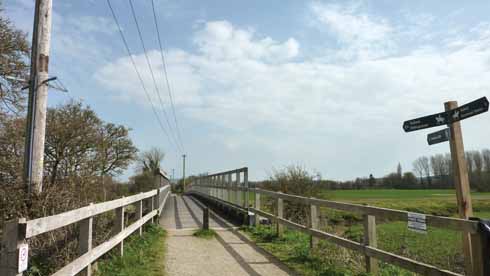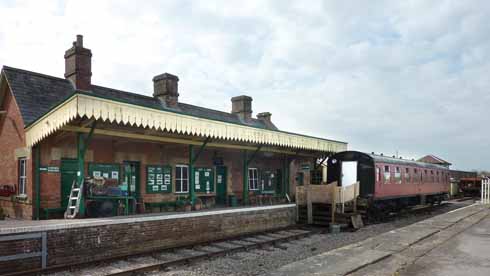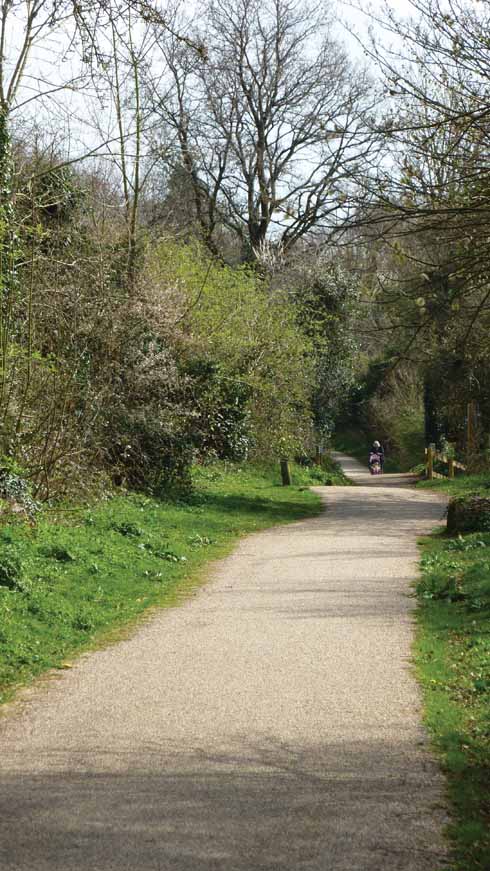The Dorset walk 2 – North Dorset Trailway
Teresa Ridout on a there-and-back or there-and-cab route suitable for cycling or walking
Published in June ’14
In 1862, when the Somerset Central Railway combined with the Dorset Central Railway, the merged company had the ambition to provide a cross-country link between the Bristol Channel and the English Channel. However, as Dorset was an agricultural county with little industry or trade, the Somerset & Dorset (S&D) soon found itself in dire financial straits and failed to attract the anticipated trade and revenue. By 1875 the company was forced into receivership; bought up and renamed the Somerset and Dorset Joint Railway it somehow always remained known as the S&D – or by its affectionate nickname of the ‘Slow & Dirty’.
Travelling through some of the finest scenery in the south and through its use of a variety of locomotives, the Somerset and Dorset Joint Railway was viewed by many to be the finest railway in the country and yet, despite active campaigning, the whole S&D route from Bath to Bournemouth was closed and dismantled amongst 750 miles of closures that took place in 1966 under the Beeching cuts.
Today the track-bed of the Somerset and Dorset Railway has been reborn as the North Dorset Trailway Network – a charity dedicated to extending and improving the old track-bed route, currently in five sections, to take walkers and cyclists through the spectacular North Dorset countryside, towns and villages. With views of two iron-age forts – Hambledon Hill and Hod Hill – and the meandering River Stour, this multi-use bridleway is proving to be ideal for families, walkers, cyclists and horse-riders and, as it has been constructed to mobility specifications, it is accessible wheelchairs and for parents with pushchairs.
Sturminster Newton station, one of the most important towns along the S&D route, was opened in August 1863 and consisted of two platforms on a passing loop: essential on a largely single-track route. Behind the platform was an extensive goods yard and sidings with buildings for stock, goods, offices and a milk depot. There is virtually no sign of the station today following its demolition in the 1970s, all that remains is a former storage building – now a carpet shop – and a large car park. In 2007 the Town Council established the Railway Gardens to commemorate the S&D and a section of the railway’s original track is on display. Sturminster Newton Museum has a permanent display in the Railway Room with a working model of the former station and surrounding area.
A short distance along the Trailway is the small hamlet of Fiddleford. Fiddleford Manor is a medieval manor house, possibly built for William Latimer who was sheriff of Somerset and Dorset. There has been a property on this site since at least the 11th century and a mill at Fiddleford is mentioned in the Domesday Book in 1086. The hall and solar chamber have outstanding roof timbers which are claimed to be the most spectacular in Dorset and certainly reflect the original owner’s rising status and ambition, providing a magnificent great hall in which to host lavish entertainment.
Travel four miles from Sturminster Newton and the Trailway comes to Shillingstone where the last surviving main station buildings can be found. Sited at the north end of Shillingstone, the station that also served Child Okeford and Okeford Fitzpaine, was formerly known as Shilling Okeford.
In 2003 the lease of Shillingstone Station was granted to North Dorset Railway Trust who have since embarked on a lengthy and expensive heritage restoration project. The Trust’s intention is to restore the station to its former glory and to provide visitors with a nostalgic journey back through time to the 1950s and 60s. They aim to establish a railway and lifestyle museum with working locomotives and rolling stock and to lay down a thousand metres of track with points, an operational signal box and a restoration shed for locos and carriages – currently there is a cafe and picnic area available and a museum of artefacts and a working diesel shunter on a short stretch of line.
For Blandford, the railway provided a significant role in developing the importance of the town and was key to growth in its commercial status during the Victorian era, it was even briefly extended by the addition of a branch line. With the outbreak of World War 1, Naval Reservists were called up for full-time service and a base depot and training camp was established at Blandford in 1914 with a German POW camp alongside it. The men left the camp for Gallipoli in 1915 and few survived the battle to return to camp. In 1918 it become an Intake Camp for the Royal Flying Corp so a two mile branch line was built to join the main SDJR to the camp, this line also brought in large numbers of civilian staff who travelled daily from Bournemouth and the surrounding areas. Like Sturminster Newton, Blandford’s Town Museum has a model railway reconstruction of the town’s station.
ATTRACTIONS EN ROUTE
Sturminster Newton Museum & Mill Society. Open April – End December Monday, Thursday, Friday & Saturday.
See website for opening times and other dates –
www.sturminsternewton-museum.co.uk
Fiddleford Manor. Open 1 April – 2 November 2014. See website for opening times – www.english-heritage.org.uk/daysout/properties/fiddleford-manor
Shillingstone Railway Station Project. Open Wednesday, Saturday and Sunday 10.00–4.00. www.shillingstone-railway-project.org.uk
The Royal Signals Museum, Blandford. Open all week. Photo ID required for entry. See website for opening times www.royalsignalsmuseum.co.uk
Blandford Town Museum is open Monday to Saturday, 10:30-16:30 from April and until the end of October.
www.blandfordtownmuseum.org
THE ROUTE
Leaving Sturminster Newton at the lower end of Station Road car park, follow the yellow or blue Public Right of Way arrow. The first section of the Trailway covers a four-mile route to Shillingstone.
Fiddleford is about a mile and a quarter south of Sturminster Newton. If diverting to Fiddleford Mill and Manor then look for a right turn approximately fifty yards after the bridge over the River Stour.
Continuing along the Trailway the route continues and is clearly marked crossing Hammoon Lane and into Bere Marsh Drive. At the end of Bere Marsh Drive cross Haywards Lane and continue on the track to Shillingstone to the Railway Project.
Leaving Shillingstone the Trailway continues over Hodway Lane and then crosses the River Stour again and then the River Iwerne before passing to the south of Stourpaine. The route continues towards Blandford with the A350 on the right hand side. The Trailway is extremely clear and easy to follow and enters Blandford at The Milldown.
There is a taxi rank in Sheep Market Hill (by the parish church of St Peter and St Paul) in Blandford for return journeys. ◗
The North Dorset Trailway – Cycle/Walk Trail
Distance: Sturminster Newton to Blandford Forum: 8 miles
Terrain: Firm and dry surfaces, mostly flat apart from a steep gradient approaching Blandford. Free from motorised traffic.
Start: Sturminster Newton – entrance next to the main car park
Parking/refreshments: Parking – Station Road car park off the B3091. Plenty of places for refreshments en route – Poets Corner Cafe, Sturminster Newton; Fiddleford Inn, Fiddleford; Shillingstone Station; The Old Ox, Shillingstone; White Horse Inn, Stourpaine;
Maps: OS Explorer 129, OS Landranger 194





